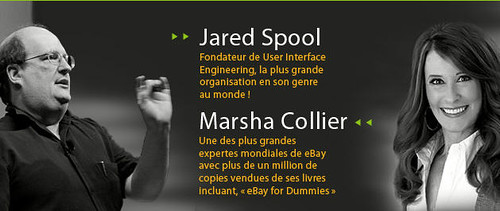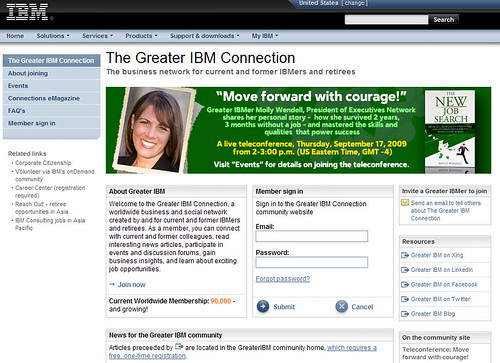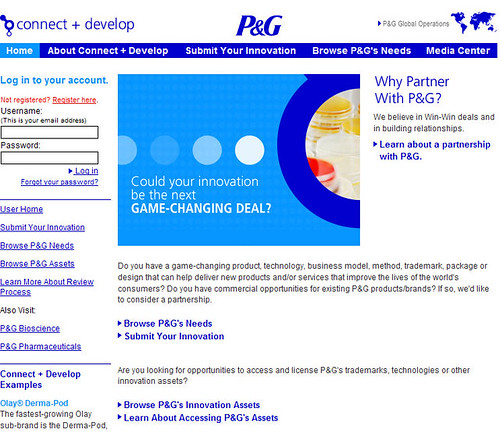Je reproduis ici quasi intégralement (mais avec quelques commentaires intercalés) les propos tenus par Dwayne Spradlin, CEO d’InnoCentive dans une entrevue à Kermit Pattison de Fast Company. Bien sûr, il y est question du sujet qui me préoccupe beaucoup par les temps qui courent : La dématérialisation pour stimuler l’innovation.
«In recent years, corporations have turned to open innovation to solve their toughest research problems and reduce runaway costs of R&D. Now non-profits are beginning to see prize-based innovation as a strategy for humanitarian causes too, such as developing medicines to fight tuberculosis in the developing world, cleaning up oil spills or designing solar technologies for villages in rural India and Africa.
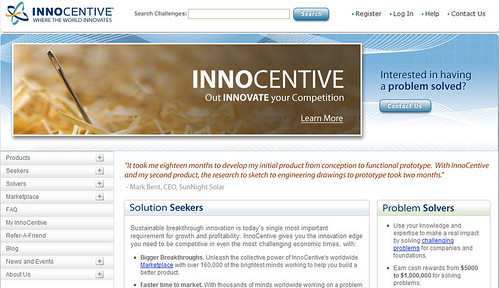
InnoCentive is the premier open innovation marketplace in the world, (ce que Don Tapscott identifie dans son bouquin Wikinomics comme étant des ideagoras) where corporations and non-profits post their toughest research problems and a global network of 160,000 solvers takes a crack at solving them for cash rewards. Non-profit challenges have grown to about 20 percent of the InnoCentive portfolio, up from virtually none only two years ago. In this Q&A, InnoCentive president and CEO Dwayne Spradlin explains why crowdsourcing is becoming a powerful tool for doing good.

–Is InnoCentive doing more in the non-profit space?
We’re doing more in the non-profit space than ever. We’ve all come here to change the world and you do that by helping organizations of all types really address their challenges. It’s particularly rewarding to work in a challenge realm that can impact human life like people’s ability to drink clean water in sub-Saharan Africa. We’re keenly interested in developing the non-profit sector. I think the data overwhelmingly supports this as an extremely powerful tool that foundations and philanthropies can use.
–People often talk about crowdsourcing as a way to tap technical expertise around the world. Is there also an untapped pool of altruism?
That’s absolutely the case. For our solver community, oftentimes this is the vehicle by which they’re able to contribute. They may not have the financial resources, but they may have the know-how to solve problems that no one else can. That gives them great satisfaction. («l’incentive» n’est pas que monétaire)
I’ll give you a wonderful example. We ran a challenge for the Oil Spill Recovery Institute out of Cordova, Alaska. They needed to find a new and novel way to get oil of the bottom of Prince William Sound from the Exxon Valdez spill. For 15 years, that oil has been sitting down there at the bottom of the ocean. They could get the oil off the bottom and onto the barges, but the surface temperature drops so dramatically that the oil almost solidifies and they can’t pump it through the barge system.
The solver ended up being an engineer out of the Midwest and he recognized a way to solve that problem using technology that’s fairly common in the construction industry. He recognized that was very similar to the problem of keeping cement liquid when you’re pouring a foundation. They used commercial-grade vibrating equipment on the barges to keep the oil fluid enough so they could process it through the system.
Anyway, the moral of the story is he won $20,000 for solving the challenge and he spent part of that money to fly himself to Cordova, Alaska because he wanted to meet the people from the foundation he was most directly associated with helping. He’s now made himself available to do work for them pro bono on future projects. There’s very little likelihood he would have had an opportunity to use his skills and resources in this philanthropic way without InnoCentive.
–How is a non-profit challenge different than a commercial one?
Certainly in the commercial space, we’re not able to be as open. Commercial entities oftentimes are running challenges anonymously. They’re very careful not to identify themselves for fears that they’ll tip their hands on business strategies. (Voilà la réponse à une question qui m’est souvent posée ) But in the not for profit space, the rules change entirely. It’s much more about openness. It’s much more about trying to drive collaboration and almost a planetary learning to drive something that ultimately benefits humankind in general.
The way we handle intellectual property between the two models is vastly different. In the commercial space, we’re typically transferring intellectual property and trade secrets. In the not-for-profit space, it really is much more about an open source form of licensing and putting into the public domain the learning and outcomes of the challenges.
–Does that make it easier to generate solutions in philanthropic efforts?
It definitely can be. We know our global solver community works on challenges for three reasons.(Intéressant) First, they want to work on problems that matter. Second, they want to be part of an elite group of problem solvers that are making a difference. And third, it’s because of the money. Not-for-profit challenges, where there’s clearly some sort of a global good associated with it, tend to draw the attention of globally-minded solvers. That means that a $10,000 or $20,000 prize—which could be quite a bit for a not-for-profit to offer—is amplified dramatically because the dividends to the solver are not only the money but also for the
–When you post a challenge, how often are they actually solved?
We solve about 40 percent of challenges on network. But what’s interesting here, particularly when you’re looking through the philanthropic lens, is we solve well in excess of 40 percent of not-for-profit problems. It’s closer to 60 percent. (Intéressant de voir que les défis des OSBL sont plus souvent relevés que ceux des entreprises. Plus simples, moins techniques ? Voir ce qu’en dit Spradlin ci-dessous))
There are two reasons for this. The first reason is there is a fundamental desire for people to work on problems that are important to the global good. We get tremendous participation for these kinds of challenges on our network, which drives higher solve rates. The second reason—and I think it’s equally important—is the not-for-profits in general have not had access to the same kinds of innovation, research and development tools as commercial enterprises. With InnoCentive and prized-based innovation, these organizations can access to the same kinds of brilliant people around the world on demand that companies have for years.
Many of them are without question cutting edge innovations. But many of them are problems that have probably been solved before, and no one has recognized the easy applicability of an existing solution to that foundation’s or philanthropy’s problems. In the case of the Oil Spill Recovery Institute, that was not brand new science, that was an innovative application of existing technologies. You have to ask yourself: if they went 15 years without solving that problem, was it because they were just looking in the wrong place? I think for a lot of the organizations that’s the case.
—(Voici une importante question concernant l’innovation et les limites du travail en silo) Oftentimes people in specific fields tend to descend into groupthink. When you flip a challenge to the outside world, do outsiders see things that people in the silo don’t see?
Innovation often happens at the boundary. The way we’ve structured innovation the last 100 years is probably insufficient to meet the world’s challenges the next 100 years. We’ve tended to build large, monolithic views of the world—if you want to solve a problem in chemistry, you hire a PhD from Stanford in chemistry. If that problem isn’t solved by that PhD or his cohort of 99 other PhDs from Stanford in chemistry, then it must be an unsolvable problem.
For the last 100 years, organizations have focused on building labs full of the smartest people in the world in a particular area. But after a certain amount of time, that silo effect envelops the organization and keeps the organization from fresh and entirely new perspectives on how to solve these kinds of problems. This prize-based model (celui d’InnoCentive) helps an organization to not only maintain that large internal organization of the best people in the world, but to augment it with up to 7 billion of the other smartest people in the world.
—(Voici une belle étude de cas) Can you give us an example?
We do work with an organization called Prize4Life, which is focused on ALS, also known as Lou Gehrig’s disease. They wanted to find a biomarker to help identify and treat Lou Gehrig’s disease patients. They decided to run the challenge in multiple phases. The first phase was a prize to anyone on earth who can come up with a new and novel way of identifying where a promising biomarker might be.
What’s amazing about this was that solutions were coming from not necessarily from the medical field. The solutions were coming in from people they had never heard of before—computer scientists, experts in bio informatics who were suggesting algorithmic approaches, machine manufacturers who knew enough about the disease to say the following kind of approach might provide a highly predictive model of who might be susceptible to this disease. They were getting solutions from outside the establishment that ended up generating some of the most innovative thinking in that field in recent years.
They ended up paying out five winners, even though their initial intent was to pay out only one, because the solutions were so much more intriguing than anything they had seen. It’s the stuff happening on the boundary, outside the silo, that actually drives innovation.
–InnoCentive has been operating eight years. (Le Crowdsourcing est un phénomène identifié comme 2.0 mais comme on le constate, InnoCentive a été fondée en 2000, soit en plein crash de la bulle techno 1.0) What has this whole experience shown the world about how you generate ideas?
Whether it’s for a commercial entity or a non profit entity, the business of business is innovation. (J’aime bien cette réponse) We all need to move our agendas, we all need to take new products to market, and we all need to find innovative ways to improve the lives of people everywhere. One of the most exciting things to happen in the last decade has been the emergence of the Internet, connected systems, social networking—all the tools to allow hundreds, thousands or millions of people to work on problems that matter. (Et celle-là également) We’re clearly proving the ability of this model to do more, faster and better than existing innovation models.
Remember, in this prize-based world, companies are paying predominantly for success. Most innovation efforts fail. With the monolithic view of R&D and innovation, one of the main reasons it’s insufficient is that you’re paying for failure. In this model, you’re paying only for the winning solutions.
–How are you continuing to build a better mousetrap when it comes to prize-based philanthropy?
Imagine challenges to which people can vote and contribute with their donations—prize amounts that grow in relation to public interest. This approach could focus millions of dollars and an extraordinary amount of attention in a way that merges free market activist philanthropy with the power of prizes. Perhaps 100,000 people could speak with their hearts, minds, and wallets to bring a challenge related to climate change into the forefront more easily than industry or government. We call the idea « crowd-funding meets crowd-sourcing » and could represent the truest form of democratic engagement in the process of innovation. This is an idea we are spending a lot of time developing and would welcome any thoughts and reactions from your readers.»
Fondé en 2000, ls site InnoCentive a été parmi les premiers à suivre cette voie avec Yet2.com. Les deux font figure de pionniers mais ils ont fait des petits. Je parle souvent de YourEncore mais il y a aussi NineSigma, Eureka Medical, TekScout mais aussi des sites d’entreprise comme MechanicalTurk, d’Amazon, P&G Connect, de Proctor & Gamble. Et que ce soit dans un but humanitaire ou strictement capitaliste, tous ces sites ont une motivation commune : Stimuler l’innovation.
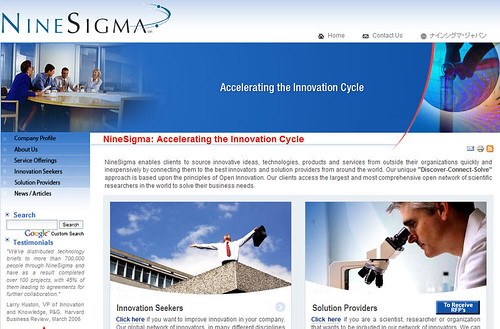
Pour une entreprise, en 2009, ces exemples doivent être pris très au sérieux et si possible imités. Il en va de leur compétitivité, de leur rentabilité et donc de leur facilité à se sortir de la présente crise économique.
 On Dec 8th we will offer 10 LeWeb registered attendees the opportunity to speak for 5 minutes and share their passion in plenary.
On Dec 8th we will offer 10 LeWeb registered attendees the opportunity to speak for 5 minutes and share their passion in plenary.
